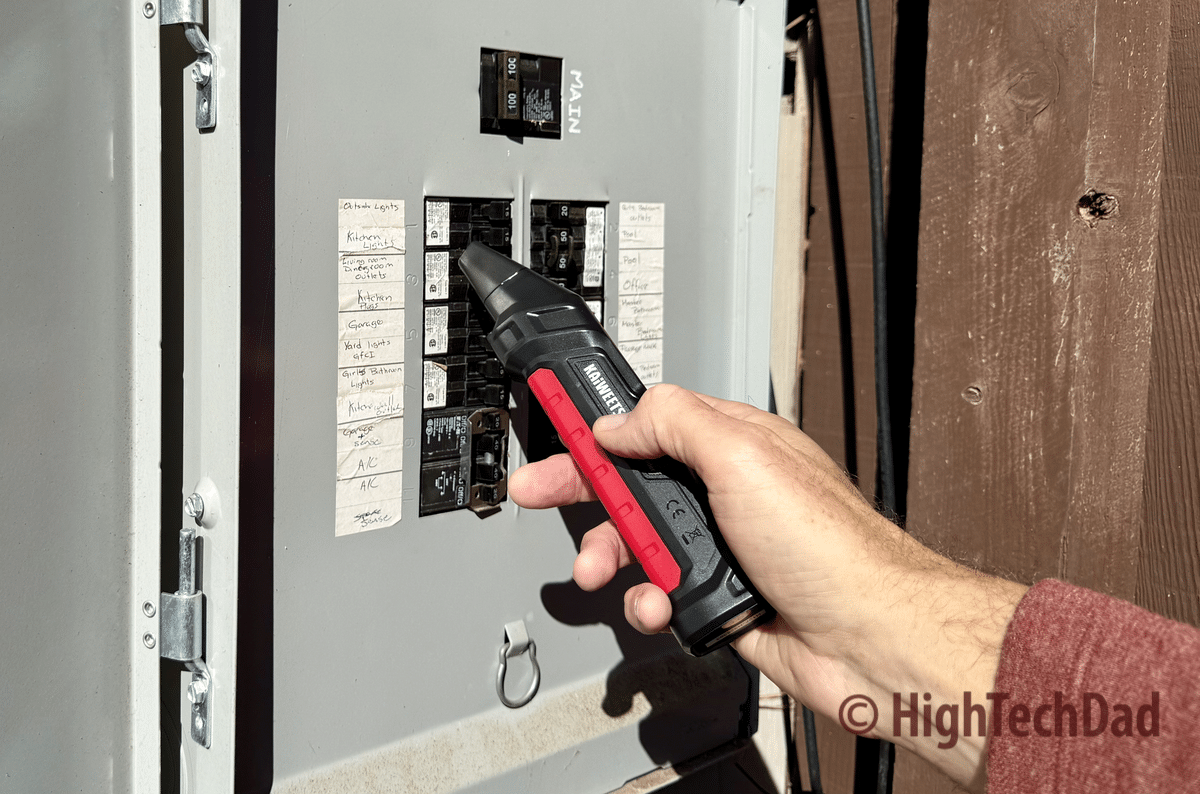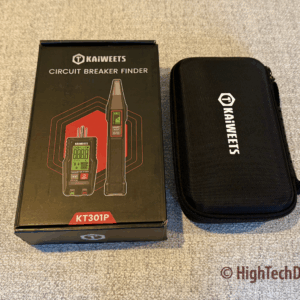A couple of months ago, my plumber accidentally cut through an electrical cord while replumbing my kitchen sink. The refrigerator went out. Wall outlets behind me stopped working. I’ve done enough electrical work over the years to feel comfortable rewiring it myself, but standing at my breaker panel for 20 minutes trying to figure out which circuit controlled those cut wires? That was frustrating. I had a voltage detector, and I was checking for hot lines under the house, but it still took forever to identify the right breaker. The KAIWEETS Circuit Breaker Finder would have turned that 20-minute hunt into a 30-second scan. (*Disclosure below.)
I’m not an electrician, but I know how to follow code for the most part and work safely with lights, plugs, and basic wiring projects. The technical work didn’t bother me. It was the detective work at the breaker panel that ate up my time. If you’ve ever stood there flipping switches one by one, testing outlets, going back and forth, you know exactly what I’m talking about.

KAIWEETS reached out and sent me their circuit breaker finder to review. I wish they’d contacted me earlier when I had this electrical outage. This tool solves exactly the problem I faced, and I’m going to show you how it works using the same type of scenario I dealt with during my plumbing disaster.
In this review:
- The KAIWEETS Circuit Breaker Finder (model KT301P) instantly identifies which breaker controls any outlet or fixture
- Key features include circuit tracing, GFCI testing, wiring verification, and non-contact voltage detection
- Best for DIY homeowners, electricians, and anyone working with residential electrical systems
- Priced between $60-70 with a protective case and all necessary adapters included
- A genuinely useful tool that eliminates guesswork on electrical projects
Table of Contents
Watch My Video Review
I recorded a complete video walkthrough showing this device in action. You’ll see me open the box, explain what’s included, and run through actual tests on my refrigerator circuit and the outdoor GFCI outlet. The video shows the circuit scanning process in real time and what the interface looks like when you’re actively using it.
The video complements this written review by giving you a visual sense of how fast the device works and what you can expect during setup. If you want to see the tool performing its circuit identification and GFCI testing functions, the video captures that hands-on experience.
What You Get with the KAIWEETS Circuit Breaker Finder KT301P
Everything arrives in a hard protective case with a handle. It’s a proper case that keeps all the components organized and protected. When you’re carrying tools around, having everything self-contained in one spot makes life easier.
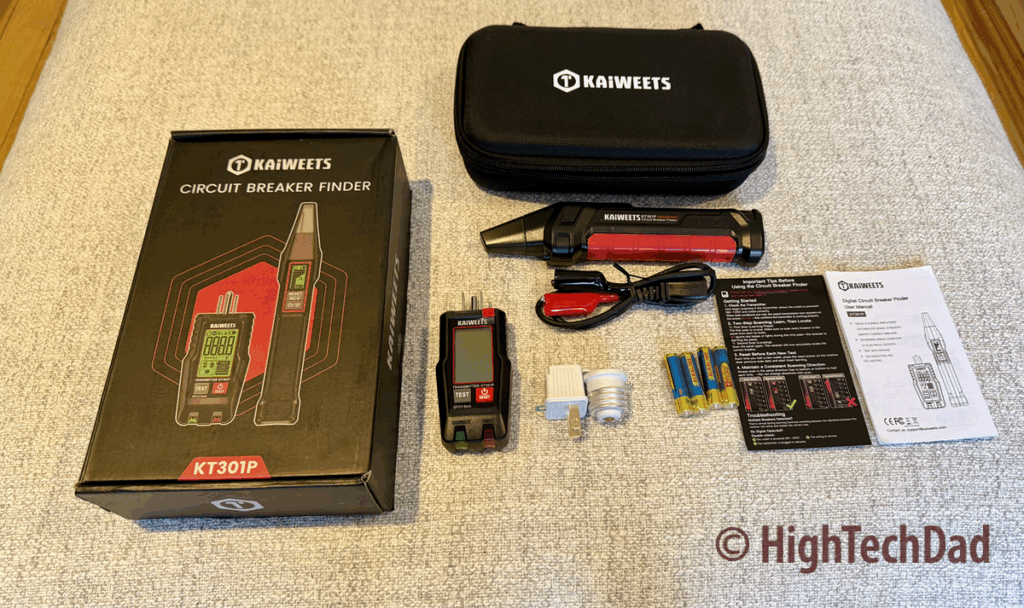
Inside the case, there’s the receiver wand (I started calling it the “magic wand”), the transmitter unit that plugs into outlets, and several adapters for different testing scenarios. You get a light socket adapter for testing fixtures, a three-to-two prong adapter, and pigtail connectors for testing bare wires. KAIWEETS includes two sets of batteries since both the transmitter and receiver need power.
The manual includes a quick-start guide with clear diagrams that show the calibration process and the different testing modes. I didn’t read it before my first test, but when I looked through it later, the instructions made sense. Setup takes maybe two minutes – pop in the batteries, turn everything on, and you’re ready to start.
How It Identifies Circuits
The basic function is straightforward: plug the transmitter into an outlet, calibrate the wand with your specific circuit breaker, then scan your breaker panel with the receiver wand, and it beeps and lights up when you hit the correct breaker. But there are several other capabilities built into this device that make it more than a single-purpose tool.
The socket connection detection verifies if the outlets are wired correctly. When I plugged it into my refrigerator outlet, it displayed the voltage – hovering around 119-120 volts, which is exactly right for my house – and showed a green light confirming proper wiring and grounding. That’s the information you want, especially in older homes where previous owners might have done questionable electrical work.
The GFCI testing function is something I tried on my outdoor outlet (one that I had wired and installed myself). Ground Fault Circuit Interrupters are safety devices that need to be wired correctly to actually protect you. With this tool, you press and hold the test button, which triggers the GFCI and tells you pass or fail. Mine passed, which gave me confidence in the installation I’d done.
There’s also a non-contact voltage (NCV) mode built in. This is the type of tool I was using during my plumbing incident to check which wires were hot. Having it integrated here means you’re carrying one device instead of multiple tools, and you can switch modes with a button press.
Testing on My Home’s Electrical System
The circuit detection process starts with a calibration step. You run the receiver down your breaker panel in one direction at a steady pace. This lets the device map out your panel’s electrical signature. After that initial scan, you move the wand slowly down the breakers again, and it lights up with a solid tone when you hit the right one.
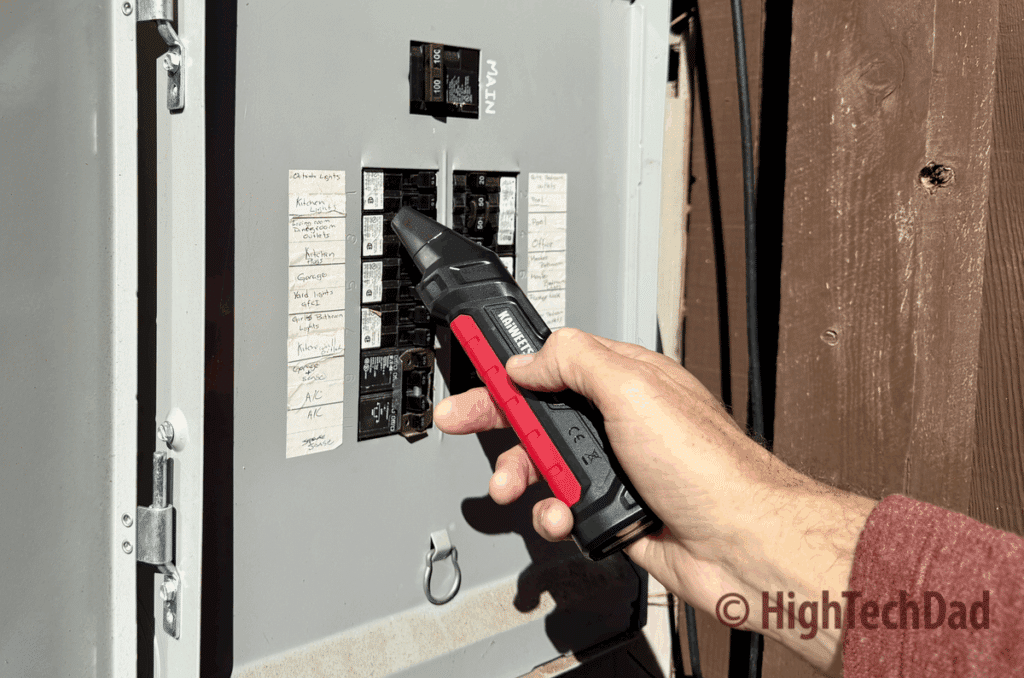
I tested this on my refrigerator circuit. The receiver lit up right at the breaker labeled “kitchen plugs” and gave me that steady beep confirming the match. My breaker panel is pretty densely packed with circuits close together, but the device still pinpointed the correct one. That would have saved me at least 15-20 minutes of the trial-and-error I went through.
The GFCI test on my outdoor outlet worked as advertised. I plugged in the transmitter, confirmed it was wired properly, then held down the test button. The unit triggered my GFCI, displayed “PASS” on its screen, and I walked over to reset the outlet. Knowing that the safety device is wired correctly and actually functioning matters.
One thing I noticed while filming: my phone overheated in the sun at the breaker panel. The KAIWEETS device kept working fine in the heat, which tells me it can handle typical outdoor conditions where many breaker panels are located.
Who Benefits from This Tool
This device shines in specific scenarios:
- DIY Homeowners Doing Electrical Work: If you’re comfortable with basic wiring but want to work safely and efficiently, this eliminates the most tedious part of any electrical project.
- Home Inspectors and Real Estate Professionals: Quickly verifying that outlets are properly wired and GFCIs function correctly adds value to inspections without eating up time.
- Electricians and Handymen: Even professionals spend time hunting for circuits in unfamiliar homes. This device pays for itself in saved labor hours after a few jobs.
- Anyone Troubleshooting Electrical Issues: When something stops working and you need to identify the circuit, or when you’re trying to figure out what’s connected to what before starting a project, this tool answers those questions immediately.
Technical Specifications
The KT301P model designation indicates this is KAIWEETS’ latest version. Understanding what it can handle helps you know if it fits your needs.
| Specification | Details |
|---|---|
| Operating Voltage Detection | Displays actual voltage at outlet |
| Circuit Detection | Calibration-based scanning system |
| GFCI Testing | Built-in test and verification |
| NCV Mode | Non-contact voltage detection |
| Additional Features | Flashlight, data hold, backlight, auto power-off, low battery indicator |
| Power Source | Batteries (2 sets included) |
| Included Accessories | Light socket adapter, 3-to-2 prong adapter, bare wire pigtails, protective case |
The device handles standard residential voltage ranges. During my testing, it consistently displayed voltage readings between 119 and 120 volts, which matched my home’s electrical system. The backlight and flashlight features let you work in dimly lit areas, such as cramped electrical panels, without needing a separate light source.
The Good and the Not-So-Good
After putting the KAIWEETS Circuit Breaker Finder through real tests on my electrical system, here’s my balanced assessment.
What Works:
- Speed and Accuracy: Circuit identification that used to take me 20 minutes now takes under a minute
- Multiple Functions in One Tool: Circuit finding, GFCI testing, voltage display, and NCV mode means you’re carrying one device instead of several
- Excellent Organization: The hard protective case keeps everything together, making it easy to grab and go
- Included Accessories: All the adapters you need for different scenarios come in the box, including batteries
- Clear Feedback: Both visual (lights on receiver and transmitter) and audio (tone that changes when you find the right circuit) make it easy to use
Room for Improvement:
- Calibration Required: You need to do an initial scan of your breaker panel before each use, which adds a step
- Dense Panels Can Be Tricky: In breaker boxes with circuits packed close together, you sometimes get slight signals from adjacent breakers
- Battery Dependency: Both units need batteries, so you’ll want to keep spares on hand
The limitations are pretty minor. The calibration step takes about 10 seconds and ensures you get accurate results. Even with the occasional need to double-check in dense panels, this is infinitely faster and more reliable than the old trial-and-error method.
Frequently Asked Questions About the KAIWEETS Circuit Breaker Finder
-
How accurate is the circuit detection in finding the right breaker?
In my testing on my refrigerator circuit and outdoor outlets, the device accurately identified the correct breaker. The calibration process helps it distinguish between different circuits, even when breakers are physically close together. The combination of the visual indicator and audio tone makes it clear when you’ve found the right breaker.
-
Can this device be used by someone with no electrical experience?
The basic circuit-finding function is straightforward enough for anyone to use safely. You plug the transmitter into an outlet, scan the breaker panel with the receiver, and it tells you which breaker controls that outlet. But if you’re using the bare wire adapters or working with live electrical components, you need to understand basic electrical safety. The tool itself is user-friendly, but electricity requires appropriate caution and knowledge.
-
Does it work on both 120V and 240V circuits?
The device is designed for standard residential electrical systems and displays voltage readings for the outlets you’re testing. I tested it on standard 120V circuits, which is what most home outlets use. For specific compatibility with 240V circuits, such as those for dryers or electric ranges, check the technical specifications on the manufacturer’s product page.
-
How long do the batteries last with regular use?
The device includes an auto power-off feature to conserve battery life. During my testing over several days with multiple circuit identification sessions and GFCI tests, I didn’t experience any battery drain issues. KAIWEETS includes two complete sets of batteries (one for the transmitter, one for the receiver). For occasional DIY use, you’ll likely get months of service before needing replacements.
-
Can I use this to map out my entire home’s electrical system?
Yes. You could systematically plug the transmitter into every outlet, scan to find its breaker, and label your breaker panel accordingly. This would give you a complete map of your home’s electrical system, which is useful for future projects, troubleshooting, or just understanding your house better. The process would take maybe an hour for a typical home, but you’d have that information documented.
Where to Buy and What It Costs
The KAIWEETS Circuit Breaker Finder retails in the $60-70 range, depending on where you purchase it. Right now, it’s available on Amazon for about $55, and you can find it on KAIWEETS’ website for approximately $70. Both sources offer the complete kit with all accessories and the protective carrying case.
For a tool that combines multiple functions and saves significant time on electrical projects, I think that price point is reasonable. Compare it to buying separate tools for circuit finding, voltage testing, GFCI verification, and NCV detection, and you’re getting good value. The included case and comprehensive accessory set mean you don’t need to make additional purchases to use it effectively.
Purchase on HighTechDad
The product shown below (and related products that have been reviewed on HighTechDad) is available within the HighTechDad Shop. This review has all of the details about this particular product, and you can order it directly by clicking on the Buy button or clicking on the image/title to view more. Be sure to review other products available in the HighTechDad Shop.
-
KAIWEETS Circuit Breaker Finder KT301P
Original price was: $59.99.$55.99Current price is: $55.99.
Why This Tool Earned a Permanent Spot in My Toolkit
I’m genuinely happy to have the KAIWEETS Circuit Breaker Finder as part of my tool collection now. After experiencing the frustration of hunting for circuits the old-fashioned way, having a device that solves that problem in seconds feels almost magical. The multiple functions mean it’s not gathering dust between uses – I’ve already found myself reaching for it to verify outlet wiring and test GFCIs.
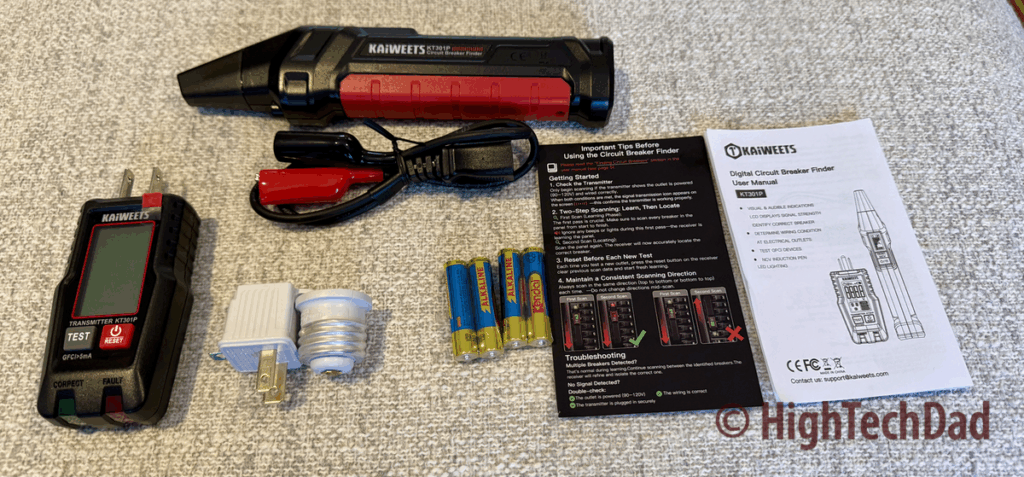
If you do any DIY electrical work or just want to better understand your home’s electrical system, this tool makes the process dramatically easier. Electricians and handymen will appreciate the time savings on every job. Even if you’re just properly labeling your breaker panel (which every home should have), this device turns that from a tedious afternoon project into a quick task.
Is this something you’d add to your toolkit? I’d love to hear about your experiences with circuit identification or whether you’ve found other uses for tools like this. Drop a comment below and let me know what you think.
Disclosure: I have a material connection because I received a sample of a product for consideration in preparing to review the product and write this content. I was/am not expected to return this item after my review period. All opinions within this article are my own and are typically not subject to editorial review from any 3rd party. Also, some of the links in the post above may be “affiliate” or “advertising” links. These may be automatically created or placed by me manually. This means if you click on the link and purchase the item (sometimes but not necessarily the product or service being reviewed), I will receive a small affiliate or advertising commission. More information can be found on my About page.
HTD says: The KAIWEETS Circuit Breaker Finder turns 20 minutes of breaker-flipping frustration into 30 seconds of confident circuit identification – it’s the tool I wish I’d had during my plumbing disaster, and now it’s staying in my toolkit permanently.
HighTechDad Ratings
-
Ease-of-Use
-
Family-Friendly
-
Price Point
-
Features
Summary
The KAIWEETS Circuit Breaker Finder turns 20 minutes of breaker-flipping frustration into 30 seconds of confident circuit identification – it’s the tool I wish I’d had during my plumbing disaster, and now it’s staying in my toolkit permanently. Honestly, I’m surprised I survived this long without a tool like this. I did have a no-contact voltage finder but the KAIWEETS has that built in, plus a lot of other functionality like testing to see if plugs are properly wired and grounded, if GFCIs work properly, but most importantly, being able to test any type of outlet (lamp, bare wires, or plug…even 2-pronged plugs) to quickly and easily identify which circuit breaker switch to turn off.
Pros
- Easy to use
- Multiple functions in a single tool
- Good price point
Cons
- Functionality is dependent on a “well-wired” circuit breaker
